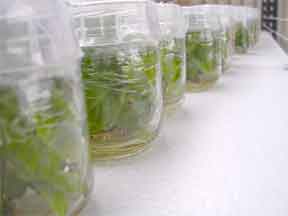In the commercial production of tissue culture plantlets, there are four stages as follows:
Stage I
This stage involves the establishment of a rapidly developing culture that is free of pathogens. The propogule that is used varies as to the plant cultured. The microcutting may be a shoot tip, root, petiole or any number of other plant parts. The optimum type of microcutting used varies from species to species, and has to be determined by trial and error. This is a costly and time consuming process and contributes to high production costs. The major problem in Stage I is to produce the culture asceptically. In some cases when this is done, the plantlets can be indexed and used as propogules for other cultures.
Stage II
Rapid development of tissue culture. The Stage I contaminant-free culture is used to initiate this stage. The primary function of Stage II is to increase the number of plantlets.

Stage III
Stage II plantlets are transferred to Stage III vessels (usually larger size than those used in Stage II). This stage is a transition stage from the in-vitro (glass) environment to the in-vivo (natural) environment, which means conditioning the plantlet produced in the laboratory to an environment like that in a greenhouse. During Stage III, shoot producing cytokinin is reduced and the auxin level is increased to stimulate rooting.
Light levels are increased to greenhouse levels. During the two to three weeks of Stage III, the necessity of increasing the light levels (usually with artificial light), leads to a very high energy cost. Some tissue culture labs have found ways to skip this stage and move directly from Stage ll to Stage IV.
Stage IV
Establishment in Soil. This is the critical stage in tissue culture of plants. Plantlets are taken from the vessels and established in soil. This stage can be conducted in the production greenhouse or at the tissue culture lab’s greenhouse. Due to the facilities sterile conditions required for Stage III plants, most production nurseries prefer to start with Stage IV rather than Stage III plants.
The critical changes the plant undergoes in this stage are related to light and humidity. These two factors have to be carefully managed if the plantlet is to survive. This can be done with shading for control of light and a variety of humidity manipulation techniques, including misting or by using a fog system. Besides these two factors, the plantlets must be kept warm to ensure rapid development.


{ 0 comments… add one now }
You must log in to post a comment.